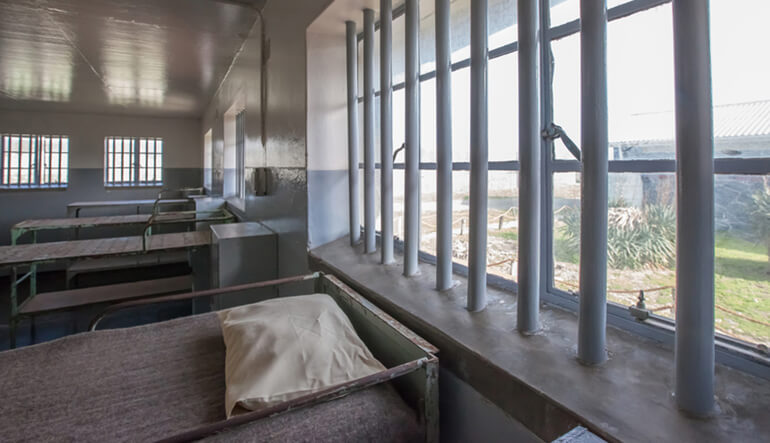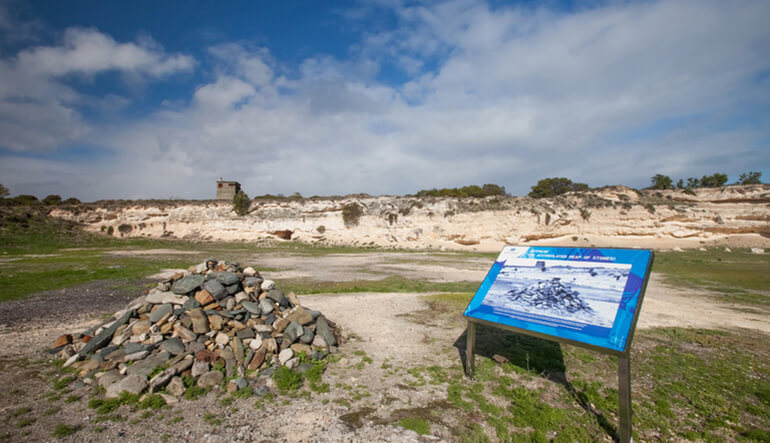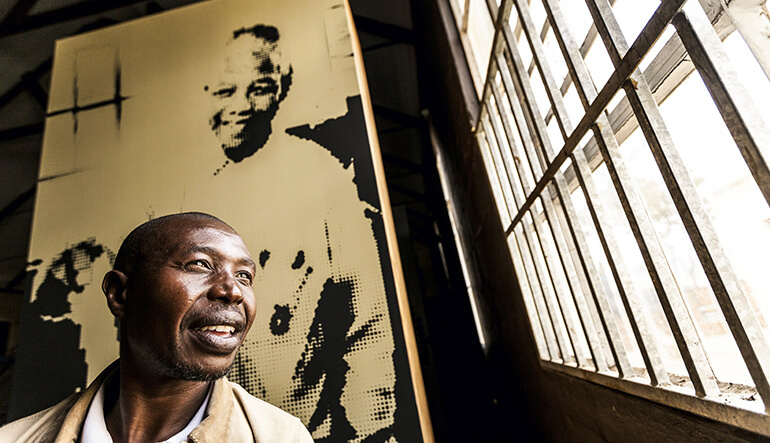Robben Island is a small landmass located off the coast of Cape Town, South Africa. A UNESCO World Heritage Site, the island is most known for housing the Robben Island prison where South Africa’s late president, Nelson Mandela, spent 18 of his 27 years of incarceration before being elected as the country’s first democratic president.
Robben Island has earned its place in history of being a maximum-security prison for anti-apartheid political leaders from 1961 to 1996. After the political prison was shut down, the island became a museum for visitors and tourists to pay homage to the resilient leaders who fought for South Africa’s democratic society.
The History of Robben Island
When the Dutch arrived in the Cape in 1652, they began using the small island just off the shore of the city as a grazing station for sheep and cattle. The island was kept for grazing until 1806, when the British annexed the Cape, seeing the island become a whaling station up until 1820.
In 1845, a colony of lepers were banished to the island and were soon joined by other outcast members of society, including paupers, alcoholics, criminals, mentally ill patients and more. In 1931, those living on the island were moved to the mainland, and the island became a military base during World War 2.
In 1961, the island was separated from the mainland. After this, the South African apartheid government opened a maximum-prison and started using the prison for religious leaders, political prisoners, convicted criminals and anti-apartheid activists.
The Robben Island prison
The prison was notorious for its harsh conditions and cruel treatment of prisoners. The prisoners had to comply with Robben Island maximum security structures and were forced to do tasks such as breaking rocks into gravel under harsh weather conditions. Prisoners were kept in solitary confinement which was primarily used as a means of punishment and torture.
Robben Island is famous for the many anti-apartheid freedom fighters incarcerated there. Members of the ANC, PAC and other organisations including the SA Congress of Trade Unions, National Liberation Front and the Communist Party were imprisoned on Robben Island for their anti-apartheid activism.
In 1964, famous anti-struggle figures, Nelson Mandela, Walter Sisulu, Govan Mbeki and other ANC leaders were sent to imprisonment on the island. After decades of gruelling incarceration, finally, in 1996, following the unbanning of political organisations in 1990, all political prisoners were granted freedom and were released from Robben Island.
Why is it called Robben Island? If you’re wondering why it is named Robben Island, the word ‘Robben’ is the Dutch word for seal, named after a large colony of seals that once populated the land.
An Overview of the Robben Island Tour
Robben Island is a reminder of the brutality, violence, discrimination and injustices of the apartheid system as well as being a symbol of the resilience of the human spirit over suffering and corruption.
Each year, thousands of tourists visit Robben Island to gain a deeper understanding of South Africa’s past and to view the tiny cell where Nelson Mandela stayed for 18 years.
The Robben Island tour begins with a ferry ride that departs from Nelson Mandela Gateway at the V&A Waterfront from 9 AM, 11 AM and 1 PM daily, dependant on the weather. On average, the ferry ride to Robben Island takes approximately 30 minutes, and the entire tour lasts about three and a half hours. Once you land on the island, you will be transported by bus to the historical sites on the islands.
Guests can expect to see the leper graveyard, the lime quarry where prisoners were forced to do tasks, the army and navy bunkers and the former maximum-security prison where famous freedom fighters were incarcerated. The tour usually ends with a site visit to Nelson Mandela’s prison cell.
The former maximum-security prison is now a museum. Here, daily tours of the museum are conducted by ex-political prisoners who share their knowledge and information about the island and South Africa’s struggle, as well as their personal stories.
In years to come, the ex-prisoner tour guides will retire. At this point, it is unsure who will lead the tours, so if you are travelling to Cape Town, book a Robben Island tour while the ex-prisoners are still available.
The Robben Island tour provides fascinating insights into South Africa’s troubled political past. As well as a deeper understanding of South Africa, the struggle and the fight for freedom, a tour of Robben Island also offers detailed accounts from those imprisoned there that went on to serve essential roles in democratic South Africa.
Although the island itself is a gloomy destination, the educational value of the tour is invaluable. A visit to Robben Island is, without a doubt, a humbling experience.
The ferry ride back to the V&A Waterfront gives visitors a chance to reflect on South Africa’s triumph and soak up the natural beauty of remarkable panoramic views of Table Mountain, Lion’s Head and the Atlantic Seaboard.
A recommended experience for all visiting South Africa, find out more about the Robben Island Tour. Best tied in with a Cape Town city and Table Mountain tour or a helicopter tour above Cape Town to view Robben Island from above, contact us to create a bespoke itinerary for your time in Cape Town.
If you’re planning your vacation in Cape Town and are looking to stay in the famous V&A Waterfront, we recommend the Silo Hotel, Cape Grace Hotel, One and Only and the Commodore Hotel. If you’re looking for more activities to enjoy while at the V&A Waterfront, read our recommended list of the top 10 activities to do at the Waterfront.





Good morning,
I am Maite, a Spanish citizen that came for a visit to beautiful South Africa.
Of course very curious and interested in visiting the island were President Nelson Mandela was a political prisoner for 27 years.
It was on Monday, January 13th on the 13H00 boat tour.
The tour was fantastic and very happy and well organized . Nevertheless I have to report an awkward behavior of a prison tour guide, and hope this complaint is taken into consideration for the well being of all tourists.
Upon arrival from the boat ‘Madiba 1’ (excellent trip with very friendly and professional on board crew, we were taken on a bus drive through all the important places for us to see on the island. The tour guide was a gentle girl that left I very thankful and admired on her Robbin Island history,as well on her perfect clear English .
After the bus tour finished, we were left (the buss was full) in front President’s Nelson Mandela prison, we all said good bye,thanked and congratulated our lady buss tour guide.
As soon we arrived to the prison main door a tour guide was waiting for us.
He explained being an ex convicted on the time of apartheid.
While he was explaining his history under the shade of the entrance, we were all left there standing, under a strong sun (40 degrees heat) for over 20 minutes, I of course went under a tree, from which I couldn’t hear what he was informing…
Then he took us to the patio were some photos of Mandela were exposed. Then again everybody was left under the sun for around 30 minutes.
Finally and the worst part, This guide of whom I’m including the picture for your information, took as for a ride on the prison cells including President Mandela’s one.
That was quite quick! We finished in a huge room with chairs a film projector at the end but curiously all the windows were locked, even if they could be opened from the inside. So it started to become extremely hot.
I thought we were going to watch a film but instead he started talking about his experiences on the prison as an inmate of the apartheid time, which I really lost interest because of his previous behavior and the extreme heat I was experiencing. making me feel very uncomfortable.
There was a south african visitor, siting beside me,(who later I learned his name was Frits) to whom he asked to get up and personify a daily scene he was forced to do.
His actual language was: ‘ we were forced by the guards to make our own shit and then take our shit with us’,
The guide wanted this gentlemen to actually personify what he was commanding him to do Of course this was very insulting and it got to a point he just left and returned to his seat.
By that time I was feeling very bad, so stood up and walked towards the door which noticed was closed but not locked, so was about to open it when the guide asked me what was I doing? Kept out walking and left him mumbling something about couldn’t leave without him finishing his exposure.
The gentleman sitting beside me got up,, accompanied me to the door, I heard the guide talking strongly at him as he left to help me.
I was not surprised as he thought he could manage us as he pleased and giving orders as if we were inmates !
I really believe this person was very affected buy his years as a prisoner but he cant just take his frustrations on us.
This is supposed to be an historical tour and not a revenge act from a surely sick person.
I am watching pictures on this site and indeed its the same guide and indeed all the windows are also closed.
I would very much appreciate if you could take some actions for the near future on the prison tour benefit as:
Opening the windows and indicating to this guide to tell the atrocities that happened in those days without picking up on South African visitors to personify what he was obliged to do. Its simply not necessary to insult any normal south african visitor.
Dont know if any of the visitors did a formal complaint , but I am hereby doing to mark a point.
Thanking in advance for the consideration you take to this serious matter.
Kind regards
Maite
Your writing has a way of making me feel like I’m having a conversation with a close friend It’s so genuine and relatable